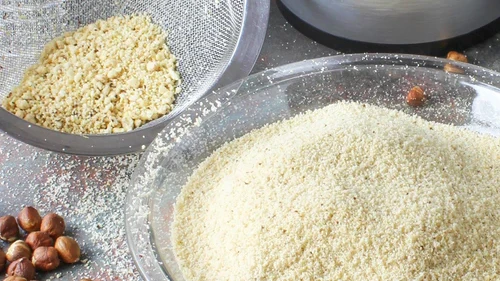Your Cart is Empty
Add description, images, menus and links to your mega menu
A column with no settings can be used as a spacer
Link to your collections, sales and even external links
Add up to five columns
Add description, images, menus and links to your mega menu
A column with no settings can be used as a spacer
Link to your collections, sales and even external links
Add up to five columns

Make fresher hazelnut flour at home in a blender
Barb Hodgens
Barb Hodgens loves to cook with alternative, healthy whole food ingredients, with a focus on gut health. Barb has overcome her own gut health issues through healthy eating. Share your ideas, comments and photos at the end of this post :)

Making hazelnut flour at home is cheaper, fresher and tastier than anything you can buy.
Hazelnut flour or (meal) is made from whole hazelnuts that are broken down to a fine texture. Grinding nuts (and other grains) at home, guarantees your baking flour is fresh and packed with the nutrition nature intended. In the Vibe Blender System, the simple process takes less than 10 seconds and just like homemade almond flour, hazelnut flour is low in carbohydrates and naturally gluten and grain free and is a great alternative to flour.
Commercial hazelnut flour is one of the more expensive nut flours and it can be often hard to find. Hazelnut flour’s high fat content also means that it is at a greater risk of going rancid. Buying and storing whole hazelnuts to make flour or meal as required is fresher, tastier and more cost effective.
Few nuts are as notably improved by roasting as the hazelnut. Briefly roasting hazelnuts before grinding intensifies their unique flavour and removes some of the moisture giving them a crunchier texture, making them easier to grind. As a bonus, roasting also helps to crisp and detach the skins which can bring a bitter taste to the flour.
It is possible to buy roasted hazelnuts and skip this step. Activating hazelnuts before grinding will also remove the bitterness that resides in the skins and give you an SCD and GAPS friendly nut flour for baking.

SIFTING HAZELNUT MEAL INTO FLOUR
Sifting the hazelnut meal is a personal choice and really depends on what you are making. If you require super fine nut flour for light and fluffy baking, we recommend this extra step. Because of the oil in hazelnuts, sifting takes some time. Note: The blender recipes we share on the ‘Luvele Life’ blog do not require sifted hazelnut flour.
STORING FRESHLY MADE HAZELNUT FLOUR OR MEAL
If you regularly use hazelnut flour or meal in your baking, then it’s a great idea to grind several cups and store it for later use. If you are planning to use it within a few days, place it in an airtight jar in the pantry. In warmer weather, keep it in the fridge. For larger quantities or if you use hazelnut flour infrequently, place it in an airtight jar, or sealed bag, in your freezer.
TIPS FOR BAKING WITH HAZELNUT FLOUR
Like other nut flours with a high oil content, hazelnut flour burns easier than wheat flour or other gluten-free grain flours. Paleo baking also often uses honey as a sweetener. This combination burns easily. To prevent spoiling your creation, lower the oven temperature a fraction and check on it 5-10 minutes before it is cooked. It may be necessary to use baking paper on top to prevent burning at the edges.

TIPS FOR GRINDING ALMONDS INTO FLOUR
- Purchase whole raw hazelnuts in bulk to save money.
- Use the clear Vibe blender jug so that you can see into the jug
- Always make sure the blender jug is completely dry.
- Blend one cup of hazelnuts at a time to ensure the nuts rotate evenly and are not weighted down onto the blades. If the jug is too full, the blender will heat up and release the natural oils in the nuts, resulting in a sticky nut flour.
- Repeat the grinding process in 1 cup increments until you have the desired amount of flour.



Make fresher hazelnut flour at home in a blender
Luvele
Rated 5.0 stars by 1 users
Hazelnut flour or (meal) is made from whole hazelnuts that are broken down to a fine texture. Grinding nuts (and other grains) at home, guarantees your baking flour is fresh and packed with the nutrition nature intended. In the Vibe Blender System, the simple process takes less than 10 seconds and just like homemade almond flour, hazelnut flour is low in carbohydrates and naturally gluten and grain free and is a great alternative to flour.
Ingredients
1 cup of whole raw or activated hazelnuts*
(Repeat in 1 cup increments until you have the desired amount of flour)
* if using activated hazelnuts jump to step 8.
Directions
- Preheat the oven to 130°C / 266°F.
Spread the hazelnuts in a single layer on a baking tray.
Bake for 15-20 minutes checking every few minutes towards the end to make sure they are roasting evenly and are not burning. They will give off a nutty aroma and the skins should start to split when they are done.
Remove from the oven.
Lay out a clean tea-towel on your bench.
Pour the hot hazelnuts into the centre of the tea-towel, fold in the edges and gently massage the bundle so the hazelnuts rub against one another and lose their skins. Don’t worry if a small amount of skin remains.
- Set the nuts aside until they are completely cold. You can put them in the fridge to speed this along. Blending warm nuts will produce sticky flour.
Add one cup of hazelnuts to the Vibe Blender jug
Blend on ‘nut’ mode for 8-10 seconds. Do not over-blend the nuts. If you blend for too long they will release oil, become sticky and be on the way to hazelnut butter.
The hazelnuts will be the texture of meal (not flour) suitable for all Luvele Life blender baking.
- Sifting the meal into a finer flour is optional. Place a wire sieve over a large bowl.
Add 1 cup of meal into the sieve then gently shake or stir until the finer grains fall into the bowl.
Place the pieces of unmilled hazelnut back in the blender jug, pulse a few times and then sift again. Repeat this process until all the meal is sifted.
Chocolate pairs well with hazelnuts so be sure to check out our healthy Nutella recipe.
PIN THIS RECIPE

Make fresher hazelnut flour at home in a blender

Making hazelnut flour at home is cheaper, fresher and tastier than anything you can buy.
Hazelnut flour or (meal) is made from whole hazelnuts that are broken down to a fine texture. Grinding nuts (and other grains) at home, guarantees your baking flour is fresh and packed with the nutrition nature intended. In the Vibe Blender System, the simple process takes less than 10 seconds and just like homemade almond flour, hazelnut flour is low in carbohydrates and naturally gluten and grain free and is a great alternative to flour.
Commercial hazelnut flour is one of the more expensive nut flours and it can be often hard to find. Hazelnut flour’s high fat content also means that it is at a greater risk of going rancid. Buying and storing whole hazelnuts to make flour or meal as required is fresher, tastier and more cost effective.
Few nuts are as notably improved by roasting as the hazelnut. Briefly roasting hazelnuts before grinding intensifies their unique flavour and removes some of the moisture giving them a crunchier texture, making them easier to grind. As a bonus, roasting also helps to crisp and detach the skins which can bring a bitter taste to the flour.
It is possible to buy roasted hazelnuts and skip this step. Activating hazelnuts before grinding will also remove the bitterness that resides in the skins and give you an SCD and GAPS friendly nut flour for baking.

SIFTING HAZELNUT MEAL INTO FLOUR
Sifting the hazelnut meal is a personal choice and really depends on what you are making. If you require super fine nut flour for light and fluffy baking, we recommend this extra step. Because of the oil in hazelnuts, sifting takes some time. Note: The blender recipes we share on the ‘Luvele Life’ blog do not require sifted hazelnut flour.
STORING FRESHLY MADE HAZELNUT FLOUR OR MEAL
If you regularly use hazelnut flour or meal in your baking, then it’s a great idea to grind several cups and store it for later use. If you are planning to use it within a few days, place it in an airtight jar in the pantry. In warmer weather, keep it in the fridge. For larger quantities or if you use hazelnut flour infrequently, place it in an airtight jar, or sealed bag, in your freezer.
TIPS FOR BAKING WITH HAZELNUT FLOUR
Like other nut flours with a high oil content, hazelnut flour burns easier than wheat flour or other gluten-free grain flours. Paleo baking also often uses honey as a sweetener. This combination burns easily. To prevent spoiling your creation, lower the oven temperature a fraction and check on it 5-10 minutes before it is cooked. It may be necessary to use baking paper on top to prevent burning at the edges.

TIPS FOR GRINDING ALMONDS INTO FLOUR
- Purchase whole raw hazelnuts in bulk to save money.
- Use the clear Vibe blender jug so that you can see into the jug
- Always make sure the blender jug is completely dry.
- Blend one cup of hazelnuts at a time to ensure the nuts rotate evenly and are not weighted down onto the blades. If the jug is too full, the blender will heat up and release the natural oils in the nuts, resulting in a sticky nut flour.
- Repeat the grinding process in 1 cup increments until you have the desired amount of flour.

 :recipekit:
:recipekit:
PIN THIS RECIPE

Subscribe
Sign up to get weekly healthy recipes & information on new product releases.
Item is added to cart


